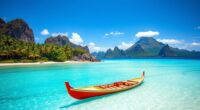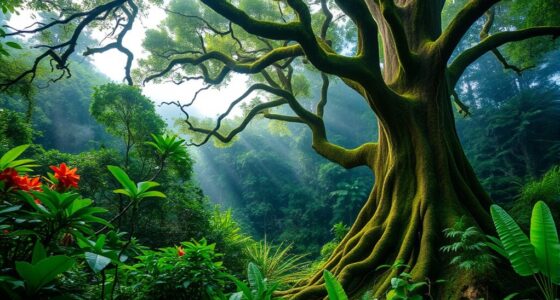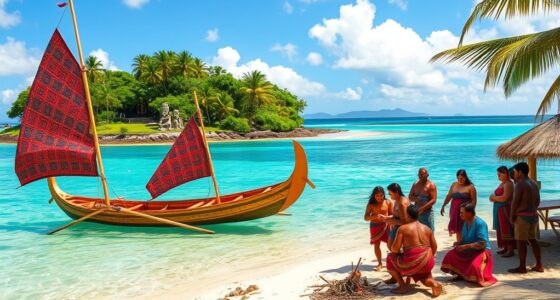If you’re planning an adventure to Micronesia, this guide covers its island groups, key landmarks like Nan Madol and WWII wrecks, and vibrant marine life perfect for diving and snorkeling. You’ll explore diverse cultures, traditions, and local cuisines while discovering the best times to visit for sunny weather. From eco-friendly accommodations to historical sites, this overview helps you navigate your trip smoothly. Keep exploring to uncover more tips and hidden gems for your Micronesian journey.
Key Takeaways
- Discover Micronesia’s island groups, landmarks, and UNESCO heritage sites like Nan Madol and WWII wrecks.
- Learn about diverse cultures, languages, traditional practices, festivals, and community customs across the islands.
- Plan your trip around the dry season (December-April) for ideal weather and optimal island-hopping experiences.
- Explore vibrant marine ecosystems with snorkeling, diving, and water activities in reefs and wreck sites.
- Choose eco-friendly accommodations, enjoy local cuisine, and practice sustainable travel to protect fragile environments.
Discovering Micronesia’s Island Groups and Landmarks
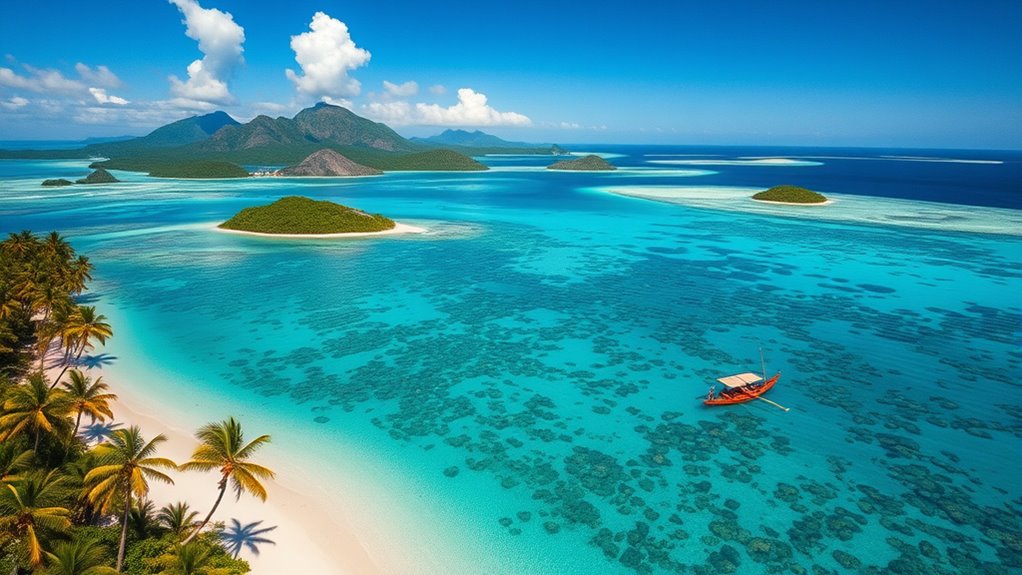
Micronesia is a diverse and expansive region made up of around 2,100 islands spread across a vast ocean area. You’ll find four main island groups: the Caroline Islands, Gilbert Islands, Mariana Islands, and Marshall Islands. The Caroline Islands include the Federated States of Micronesia and Palau, with lush volcanic islands and cultural sites like Nan Madol, an ancient stone city. Guam and Saipan in the Marianas boast WWII history and stunning beaches. The Marshall Islands feature coral atolls and World War II relics, while Kiribati’s Gilbert Islands are known for their remote atolls and rich marine life. Each group offers unique landmarks, from Pohnpei’s rainforests and waterfalls to Yap’s famous stone money, making Micronesia a mesmerizing mosaic of landscapes and histories. Exploring the diverse island groups reveals a tapestry of cultures, ecosystems, and historical sites that captivate travelers and historians alike.
Navigating the Cultural Tapestry of Micronesian Societies

You’ll notice that Micronesia’s languages and dialects reflect its rich cultural diversity, with each island group preserving unique ways of speaking. Traditional customs and practices remain essential, shaping social interactions and community life. Understanding these cultural elements helps you connect more deeply with Micronesian societies during your visit. Exploring local traditions offers valuable insights into their way of life and strengthens your cultural experience.
Indigenous Languages and Dialects
Have you ever wondered how the diverse islands of Micronesia maintain their unique cultural identities through language? You’ll find that each island group has its own indigenous language or dialect, serving as a crucial link to tradition and history. For example, Chuukese, Pohnpeian, Yapese, and Kosraean are spoken alongside English, which is official in many areas. These languages reflect local customs, social structures, and ways of life. While some dialects are mutually intelligible, others are distinct, preserving a sense of community and identity. Language is often passed down orally, with storytelling, songs, and ceremonies playing key roles. Even as modernization influences daily life, many Micronesians continue to cherish and preserve their native tongues, ensuring their cultural heritage remains vibrant. The linguistic diversity of Micronesia highlights the importance of language as a vessel for cultural preservation and identity.
Traditional Customs and Practices
Traditional customs and practices form the heart of Micronesian societies, shaping daily life and community identity. You’ll find that respect for elders, communal decision-making, and cultural ceremonies are central. Here are four key aspects:
- Canoe building and navigation connect communities through centuries-old seafaring skills.
- Yap’s Rai stones serve as a symbolic currency, used in important rituals and ceremonies.
- Family and clan ties influence social roles, with elders holding significant authority.
- Cultural festivals celebrate traditional dance, music, and storytelling, preserving history and identity.
- Understanding retail hours for local markets and shops can enhance visitors’ engagement with community events and celebrations.
Best Times to Visit and Seasonal Weather Insights

The best time to visit Micronesia is during its dry season, which runs from December to April, when the weather is typically sunny and more predictable. During this period, you’ll enjoy clear skies, calmer seas, and ideal conditions for outdoor activities like diving, snorkeling, and island hopping. This season also minimizes the risk of tropical storms and heavy rains, making travel between islands smoother. Keep in mind that December through February can be slightly cooler and more comfortable, especially if you prefer milder temperatures. Visiting during the dry season guarantees you experience Micronesia’s vibrant culture, lush landscapes, and marine life at their best. Avoid the cyclone-prone months of July through November for a safer, more enjoyable trip. Additionally, seasonal weather patterns can influence travel plans, so checking local forecasts beforehand is advisable.
Exploring the Unique Marine Ecosystems and Reefs
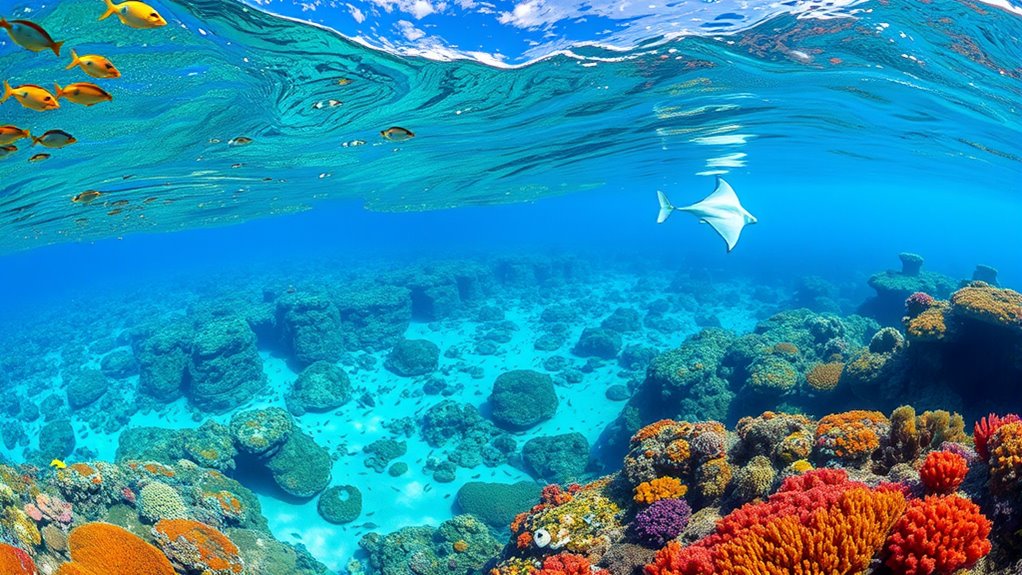
Micronesia’s vibrant marine ecosystems are a highlight for any traveler seeking underwater adventure. You’ll discover some of the world’s most diverse reefs, teeming with colorful fish, sharks, and coral formations. The region’s unique ecosystems include:
Explore Micronesia’s vibrant reefs teeming with colorful fish, sharks, and stunning coral formations.
- Chuuk Lagoon – Known for its WWII wrecks, offering fascinating diving sites immersed in history.
- Yap’s Manta Rays – Swim alongside majestic manta rays in clear, nutrient-rich waters.
- Pohnpei’s Coral Gardens – Explore thriving coral formations and vibrant marine life in protected reefs.
- Kosrae’s Rainforests and Reefs – Experience lush landscapes merging seamlessly with pristine reef ecosystems. Recognizing the importance of holistic care models can help in understanding the interconnectedness of these ecosystems and their preservation.
As you dive or snorkel, you’ll witness coral atolls, lagoons, and barrier reefs, each supporting intricate marine habitats essential for the region’s biodiversity.
Top Activities and Adventures Across the Islands

Begin an unforgettable journey by exploring the diverse activities and adventures that islands in Micronesia have to offer. Plunge into crystal-clear waters for world-class snorkeling and scuba diving, especially around Chuuk’s WWII wrecks and Yap’s manta ray encounters. Hike lush rainforests on Pohnpei to discover ancient ruins like Nan Madol or enjoy stunning vistas from volcanic high points. Experience authentic Micronesian culture by participating in traditional festivals, learning canoe-building, or exploring local villages. Kayaking through lagoons and atolls offers peaceful, scenic adventures, while fishing expeditions provide fresh catches and memorable moments. For history enthusiasts, WWII sites and archaeological sites offer fascinating insights. Engaging with local communities can enrich your understanding of cultural traditions and ensure respectful interactions. Whether seeking underwater thrills, cultural immersion, or scenic exploration, Micronesia’s islands deliver unforgettable activities for every adventurer.
Practical Tips for Traveling Between Islands
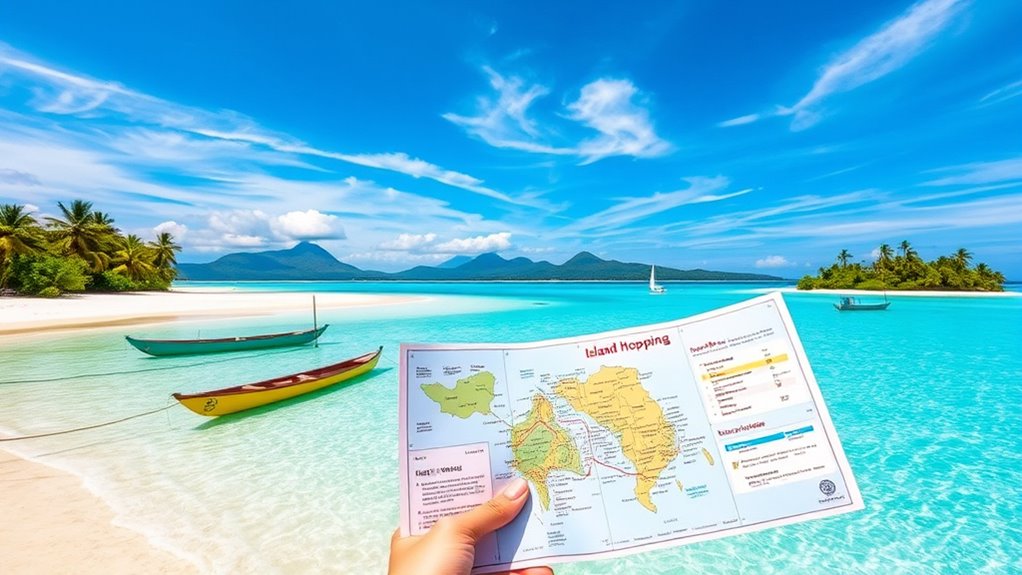
Getting around the islands requires some planning, as travel options vary widely depending on your destinations. To navigate efficiently, consider these practical tips:
- Use regional flights: Smaller planes connect major islands like Pohnpei, Kosrae, and Chuuk—book early for availability.
- Rely on ferries and boats: Many islands are linked by boat services, but schedules can be unpredictable—check in advance.
- Plan for transfers: Connecting flights often require overnight stays in Guam or other hubs—factor this into your itinerary.
- Rent local transportation: In some islands, you can rent scooters or bikes for short distances, offering flexibility and local flavor.
- Be aware of regional transportation networks: Understanding the inter-island travel options can help you make informed decisions and avoid delays.
Being prepared helps you avoid delays and makes island-hopping smoother.
Understanding Local Cuisines and Traditional Practices

Exploring the cuisines and traditional practices of Micronesia offers a fascinating glimpse into the region’s rich cultural heritage. You’ll find that food plays a central role in community life, with dishes rooted in local ingredients like taro, breadfruit, coconuts, and fresh seafood. Traditional cooking methods, such as earth ovens called “lovo,” are still common, especially during festivals and ceremonies. Each island group has unique customs; for example, Yap is famous for its Rai stone money, used in social and ceremonial exchanges. Seafaring skills, including navigation using the stars and wave patterns, remain crucial cultural practices. Respect for elders and family ties shape social interactions, and vibrant festivals celebrate ancestral traditions through dance, music, and storytelling. Embracing these practices enriches your understanding of Micronesian culture.
Planning Your Stay: Accommodation Options and Amenities

When planning your stay in Micronesia, you’ll find a variety of accommodation types, from simple guesthouses to boutique hotels. Amenities and services vary widely, so it’s important to choose options that match your needs and expectations. Understanding what’s available can help you make the most of your trip. Additionally, considering ownership essentials and maintenance needs can ensure your stay remains comfortable and hassle-free.
Accommodation Types and Styles
Whether you’re seeking a simple guesthouse or a more luxurious retreat, Micronesia offers a variety of accommodation styles to suit different preferences and budgets. Here are some options to contemplate:
- Guesthouses and Bungalows – Budget-friendly, locally run, and often family-operated, perfect for authentic experiences.
- Mid-range Hotels – Comfortable rooms with basic amenities, mainly in main islands and urban centers.
- Resorts – Located on scenic islands, these offer more luxurious amenities, private beaches, and stunning ocean views.
- Eco-lodges – Focused on sustainability, often built using local materials, ideal for eco-conscious travelers. Incorporating sustainable building practices can enhance your eco-lodge experience and reduce environmental impact.
Each option provides a unique way to experience Micronesia’s natural beauty and culture.
Available Amenities and Services
Planning your stay in Micronesia means considering the amenities and services available at your chosen accommodation, which can greatly enhance your experience. Expect a range of options from basic guesthouses to more upscale hotels, mostly in urban centers like Palikir and Pohnpei. Many accommodations provide essentials like Wi-Fi, air conditioning, and hot showers, but amenities vary widely. Some resorts offer on-site restaurants, dive shops, and tour assistance, making it easier to explore the islands. Service quality may differ, especially outside main towns. Laundry, transportation arrangements, and guided tours are often available, helping you make the most of your trip. Keep in mind that facilities tend to be simpler compared to more developed destinations, so plan accordingly for a comfortable stay.
Engaging With Micronesian History and Heritage Sites
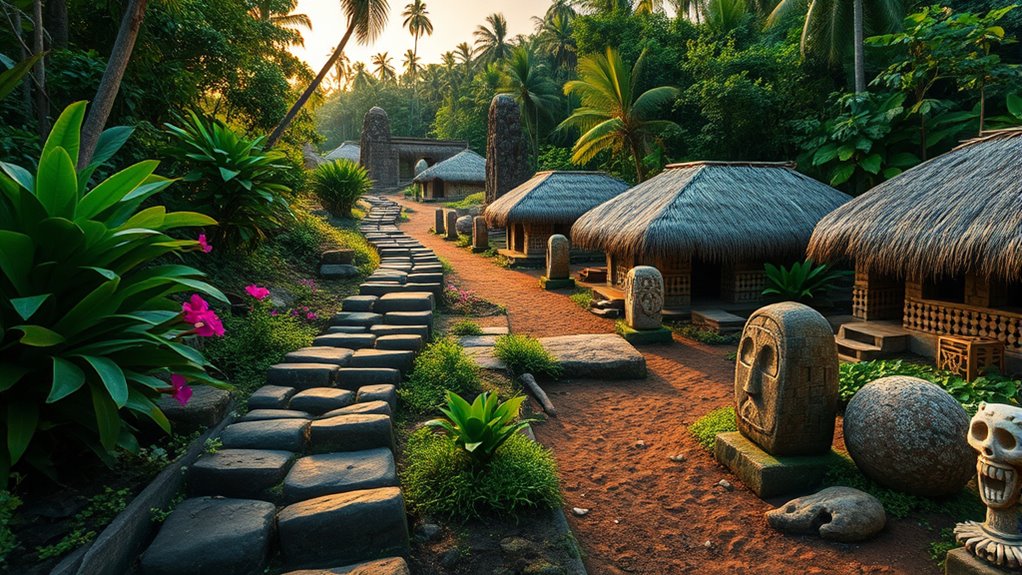
Micronesia’s rich history is vividly preserved in its heritage sites, offering you a window into ancient traditions and significant past events. You can explore structures that reveal traditional navigation skills, learn about WWII battles through wrecks and memorials, and witness centuries-old cultural practices still alive today. Here are four key sites to deepen your experience:
- Nan Madol (Pohnpei): An ancient city of stone pillars, illustrating sophisticated engineering and societal organization.
- Chuuk Lagoon: A world-renowned WWII wreck diving site, telling stories of naval battles and history.
- Yap’s Rai Stones: Large stone currency, showcasing unique economic and cultural traditions.
- Palau’s Rock Islands: Spectacular limestone formations with archaeological sites and preserved marine ecosystems.
These sites connect you directly with Micronesia’s vibrant history and enduring heritage.
Sustainable Travel and Environmental Considerations
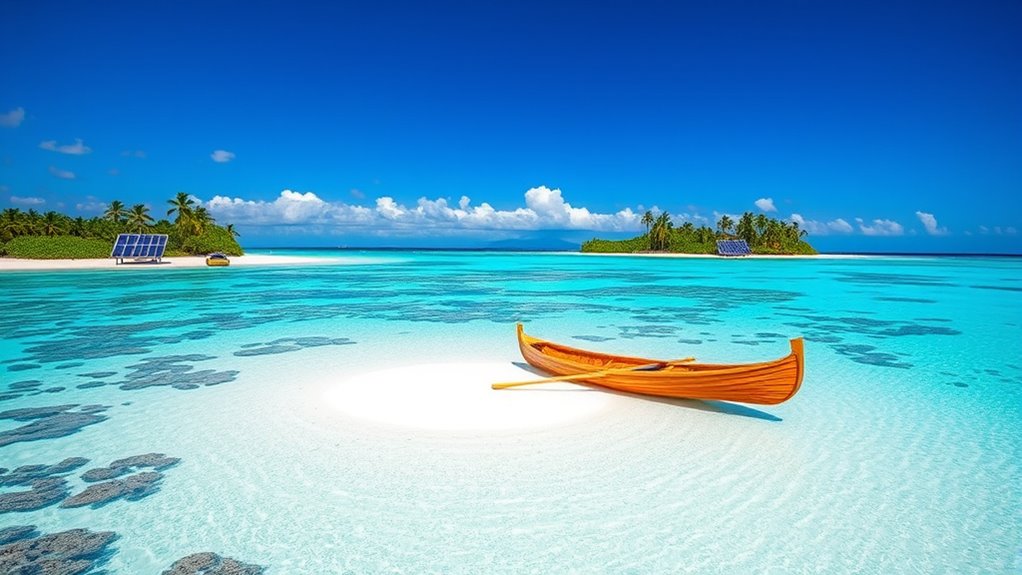
As you explore Micronesia, it’s important to consider coral reef preservation and support eco-friendly tourism practices that protect these delicate ecosystems. By choosing responsible operators and avoiding activities that damage reefs, you help guarantee these natural wonders remain vibrant for future visitors. Embracing sustainable travel strategies benefits both the environment and local communities, creating a more meaningful experience.
Coral Reef Preservation
Have you ever wondered how your visit can help protect Micronesia’s vibrant coral reefs? Your actions can make a real difference in preserving these fragile ecosystems. Here are four ways you can contribute:
- Choose eco-friendly tours that follow responsible snorkeling and diving practices.
- Avoid touching or stepping on corals, which can cause long-term damage.
- Use reef-safe sunscreen to prevent chemicals from harming marine life.
- Support local conservation initiatives by volunteering or donating.
Eco-Friendly Tourism Strategies
Adopting eco-friendly tourism practices is key to preserving the region’s unique landscapes and vibrant marine ecosystems. You can minimize environmental impact by choosing eco-conscious accommodations, avoiding single-use plastics, and respecting local habitats. Support community-led initiatives that promote conservation and cultural preservation. Responsible snorkeling and diving prevent reef damage, while reducing carbon footprints helps combat climate change. To deepen your understanding, consider this table:
| Sustainable Practice | Impact |
|---|---|
| Use reef-safe sunscreens | Protects coral reefs from harmful chemicals |
| Participate in local conservation projects | Supports ecosystem preservation |
| Opt for eco-certified tours | Ensures practices are environmentally responsible |
| Respect cultural sites and traditions | Preserves local heritage and social fabric |
Frequently Asked Questions
Are There Direct International Flights to Micronesia’s Main Islands?
You can’t find many direct international flights to Micronesia’s main islands. Most travelers arrive via Guam or other nearby hubs like Manila or Tokyo. From there, you’ll need to catch domestic flights or boats to reach places like Pohnpei, Chuuk, or Kosrae. Planning ahead helps, especially during peak seasons. Make sure to check flight schedules and connections, as options can be limited and sometimes require layovers.
What Are the Health and Vaccination Requirements for Travelers?
You need to be vaccinated against hepatitis A and typhoid before visiting Micronesia, where over 70% of the population lives in rural areas with limited healthcare access. It’s wise to get your routine vaccines updated, including tetanus and measles. No mandatory vaccinations are required for U.S. travelers, but travelers from other countries should check with their health authorities. Protect yourself and enjoy your trip safely in this beautiful, diverse region.
How Safe Is It to Travel Independently Between Micronesian Islands?
Traveling independently between Micronesian islands is generally safe, but you should plan carefully. Use reputable transportation options like scheduled flights and ferries, and always check local schedules. Exercise caution on less-developed routes, keep an eye on weather conditions, and stay updated on safety advisories. Respect local customs, carry sufficient supplies, and communicate your plans with locals or your accommodation. With proper preparation, your island-hopping adventure can be secure and enjoyable.
Is Wi-Fi Available on Most Islands and in Accommodations?
You’ll find Wi-Fi available in most accommodations and some public areas, but don’t expect high-speed connectivity everywhere. Imagine that only about 30% of islands have reliable internet access, so it’s not guaranteed on every island. In places like Pohnpei and Chuuk, you might get decent service, but on smaller or remote islands, connectivity can be spotty or nonexistent. It’s wise to plan for limited internet and enjoy the digital detox.
Are There Any Travel Restrictions Due to Climate Change or Environmental Issues?
You should be aware that climate change and environmental issues do impact Micronesia, leading to rising sea levels, coastal erosion, and coral bleaching. These changes can cause travel disruptions, such as damaged infrastructure or limited access to certain islands. While travel is still possible, stay updated on local conditions, heed advisories, and plan for potential weather-related delays. Being flexible and environmentally conscious helps guarantee your trip remains safe and enjoyable.
Conclusion
Ready to begin your Micronesian adventure? With its stunning islands, rich culture, and vibrant ecosystems, Micronesia offers unforgettable experiences at every turn. Will you embrace responsible travel and leave a positive impact? By immersing yourself in its history, savoring its flavors, and exploring its reefs, you’ll create memories that last a lifetime. So, are you prepared to discover the hidden treasures of this enthralling paradise? The journey awaits—dive in with an open heart.


